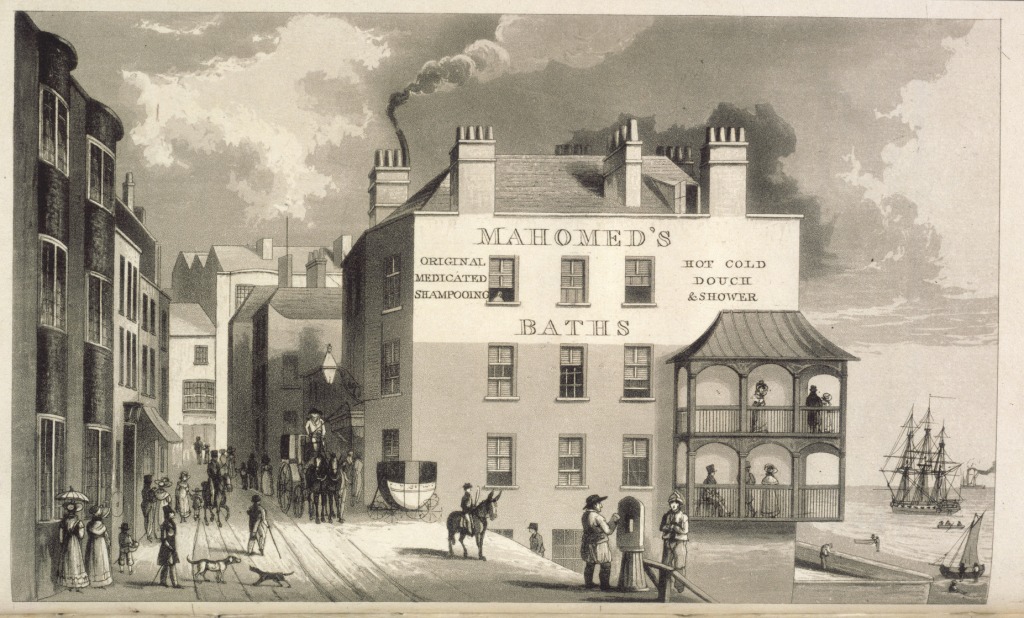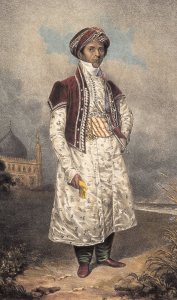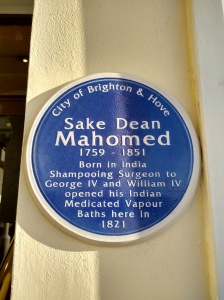Sake Dean Mahomed was born in 1759 in Patna, India to a Muslim family. His father served in the East India Company’s Bengal Army and died when Mahomed was a young boy. Following his father’s death, Dean was taken under the care of Captain Godfrey Evan Baker, an Anglo-Irish Protestant officer. He served in the army like his father as a trainee surgeon. He stayed alongside Baker until 1782, when the Captain resigned. Mahomed followed in suit and also resigned from the Army, choosing to accompany Baker, ‘his best friend‘, to Ireland.

He moved to Cork, Ireland in 1784 with the Baker family. There he studied the English language at a local school and soon fell in love with an Irish woman named Jane Daly who was described as a “pretty Irish girl of respectable parentage.” This was a pretty controversial relationship because at the time, it was illegal for Protestants to marry non-Protestants. The pair actually eloped in 1786 and Muhammad actually converted to Anglicanism from Islam. The newly married couple moved to 7 Little Ryder Street in London. They went on to have 7 children together.
In 1794, Mahomed published a book titled ‘The Travels of Dean Mahomet.’ It gives a brief autobiographical account of Dean Mahomed, his career in the army, the social customs of India and the conquest of India by the East India Company’s Army. Notably, Dean was the first Indian to publish a book in English.
In 1810, he opened the first curry restaurant in London, the Hindoostane Coffee House. The restaurant offered, among other items, hookah “with real chilm tobacco, and Indian dishes, … allowed by the greatest epicures to be unequalled to any curries ever made in England.” The restaurant also provided a home delivery service. The venture ended in 1812 when Mahomed filed for bankruptcy.

Undeterred, the family moved to Brighton where Mahomed established his most successful venture- Mahomed’s Baths where he introduced the practice of ‘champi’ or ‘shampooing.’ He described the treatment in a local paper as “The Indian Medicated Vapour Bath (type of Turkish bath), a cure to many diseases and giving full relief when every thing fails; particularly Rheumatic and paralytic, gout, stiff joints, old sprains, lame legs, aches and pains in the joints.” Jane, Mahomed’s wife, was also involved in the bathhouse business and adverts show that she too possessed the “the art of shampooing” and she superintended the Ladies Baths. The business was a great success and Dean became known as ‘Dr. Brighton’. Hospitals red patients to him and he was appointed as the ‘Royal Shampooing Surgeon’ for King George IV and King William IV. In 1822, Sake Dean Mahomed published ‘Shampooing; or Benefits resulting from the use of the Indian medicated vapour bath.’ This medical work featured testimonies from his patients, as well as details of the treatment that made him famous. This was a clever move from Mahomed as the book acted as a marketing tool for his unique baths and capitalised on the early 19th century trend for seaside spa treatments. However, in the 1830s (due to a lack of capital) Mahomed’s Baths were put up for auction and Mahomed’s family were forced to relocate to more modest accommodation in Brighton.
The trailblazing entrepreneur lived the rest of his life in relative obscurity until he died in 1851. Even after his death, the once renowned Sake Dean Mahomed began to lose prominence and was largely forgotten until the recent scholarly work.
Several commemorations of Mahomed’s legacy have taken place in the 21st century. In September 2005, the City of Westminster unveiled a green plaque commemorating the opening of the Hindoostane Coffee House. The plaque is at 102 George Street, close to the original site of the coffee house at 34 George Street. And in January 2019, Google recognised Sake Dean Mahomed with a Google Doodle on the main page.





